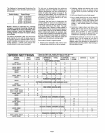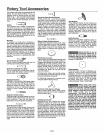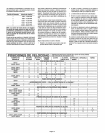
Craftsman
Rotary Power
Too
The Rotary Toot is a handful of high-speed
power It serves as a carver, a grinder,
polisher, sander, cutter, power brush, drilt and
more
The Rotary Tool has a small, powerful electric
motor, is comfortable in the hand, and is
made to accept a targe variety of accessories
including abrasive wheels, drill bits, wire
brushes, polishers, engraving cutters, router
bits, and cutting wheels Accessories come in
a variety of shapes and permit you to do a
number of different jobs. As you become
familiar with the range of accessories and
their uses, you will learn ust how versatile the
Rotary Tool is You f see dozens of uses you
hadn't thought of before now
The real secret of the Rotary Tool is its speed
To understand the advantages of its high
speed, you have to know that the standard
portable electric dril runs at speeds up to
2,800 revolutions per minute. The Rotary Tool
operates at speeds up to 30,000 revolutions
per minute The typical electdc drill is a low-
speed, high torque too!; the Rotary Tool is ust
the opposite - a high-speed, low torque tool
The chief difference to the user is that in the
high speed tools, the speed combined with
the accessory mounted in the collet does the
work. You don't appty pressure to the tool, but
simply hold and gu{de it tn the low speed
tools, you not only guide the tool, but also
apply pressure to it, as you do, for example,
when drilling a hole
It is this high speed, along with its compact
size and wide variety of special accessories,
that makes the Rotary Tool different from
other power tools The speed enables it to do
jobs low speed tools cannot do, such as
culling hardened steel, engraving gtass, etc
Getting the most out of your Rotary Tool is a
ma_ter of learning how to let this speed work
for you
Using the
Rotary Power
TooN
Read the next sections carefully They will
hetp you use your Rotary Tool correctly and
hetp you select the correct accessory for your
job
....The first step in learning to use the Rotary
Tool is to get the "feel" of it Hold it in your
hand and feel its weight and balance. Feel the
taper of the housing This taper permits the
Rotary Tool to be grasped much like a pen or
pencil
When you turn on the tool for the first time,
hold it away from your face. Accessories can
be damaged during handling, and can fly
apart as they come up to speed This is net
common, but it does happen
Practice on scrap materials first to see how
the Rotary Tool cuts Keep in mind that the
work is done by the speed of the tool and by
the accessory in the coltet. You should not
tean on or push the tool into the work
Instead, lower the spinning accessorylightly
to the workand allow it to touch the point at
which you want cutting (orsanding or etching,
etc ) to begin, Concentrate on guiding the tool
over the work using very little pressure from
your hand Aitow the accessory to do the
work
Usually, it is best to make a series of passes
with the tool rather than attempt to do alt the
work in one pass To make a cut, for example,
pass the tool back and forth over the work,
much asyou would a small paint brush Cut a
little material on each pass until you reach the
desired depth, For most work, the deft, gentle
touch is best With it, you have the best
control, are less likely to make errors, and will
get the most efficient work out of the
accessory
For best control in close work, grip the Rotary
Tool fike a pencil between your thumb and
forefinge_
This is the "handgrip" method of holding the
toolused for operationssuch as grinding aflat
surface or using cutoff wheels
_ When using the steel
saws, cutoff wheels, high
speed cutters or tungsten carbide cutters,
always have the work securely clamped.
Never attempt to hold the work with one
hand while using any of these
accessories. The reason is that these
wheels will grab if they become slightly
canted in the groove, and can kickback
causing loss of control resulting in
serious injury. Your second hand should
be used to steady and guide the hand
holding the tool. When a cutoff wheel
grabs, the wheel itself usually breaks.
When the steel saw, high speed cutters or
tungsten carbide cutter grab, it may jump
from the groove and you could lose
control of the tool.
Page 4
Operating Speeds
& Accessories
Set the speed indicator to fit the job; to
achieve the best job results when working
with different materials, the speed of the
Rotary Too_ should be regulated. Only a full
wave output speed control such as the Sears
Model 2514 (available from catalog only)
shoutd be used with the Modet 572.610520
Models 572610530 & 572610720 Rotary
Tools have an integral speed control and an
external speed control should never be used
with these tools
To select the right speed for each job, use a
practice piece of material. Vary speed to find
the best speed for the accessory you are
using and the job to be done
There are three basic types of Rotary Tools:
singte speed, two-speed and variable speed
models On the single speed model, there is
an ON-OFF switch_ When the switch is on,
the toot runs at 28,000 RPM On the two-
speed-mode!, there is a LO and H! switch
When the switch indicator is on the low
setting, the too] runs at about 20,000 RPM
When the switch indicator is on the high
setting, the toot runs at about 30,000 RPM
On the variable speed model, there is a
switch indicator with a white line on it..Slide to
the number on the housing to seiect the
operating speed needed from 5,000 - 30,000
RPM You can refer to the charts on page 5 to
determine the proper speed, based on the
material being worked and the type of cutter
or other accessory being used These charts
enable you to select both the correct acces-
sory and the optimum speed at a glance
If you have a single-speed or two-speed
model, you will be able to use many
accessories to do a wide assortment of jobs.
For the majority of applications, all models of
the Rotary Tool should be used at top speed
Needs for Slower Speeds
Certain materials, however, (some plastics,
for example) require a retatively slow speed
because at high spend the friction of the tool
generates heat and causes the plastic to melt
Slow speeds (15,000 RPM or less) usually
are best for polishing operations employing
the felt polishing accessories They may also
be best for working on de_icate projects as
"eggery" work, delicate wood carving and
fragile model parts You should always do
polishing with wire brush accessories at
slower speeds and never higher than 15,000
RPM
Higher speeds are better for carving, cutting,
routing, shaping, cutting dadoes or rabbets in
wood
Hardwoods, metals and glass require high
speed operation, and drilling should also be
done at high speeds
The speed of the Rotary Tool is controlted by
setting this indicator on the housing














